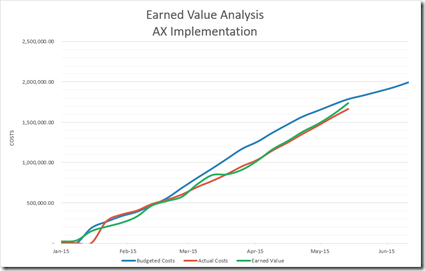Business transformation projects based on technology are notorious for being over budget, underperforming, and lacking expected results. We believe this is because most organizations (a.k.a., consultants) focus on traditional project management metrics when reporting project status. We believe it’s time to deploy EVA to EVERY transformation project you undertake.
What is EVA?
EVA is a well-known concept in some industries like construction. It is a tool used to monitor project status based on time and money. Traditional approaches track project progression based on planned or budgeted costs v. actual costs. Where EVA differs is that it adds a third dimension, work performed, specifically the value of the work performed to date.
A typical snapshot of the financial status of a project might look like this:
Using this view, this project looks to be performing amazingly well. Actual costs to date are well below budgeted costs for the project-to-date. Executive management reviewing this status would most likely be very pleased. However, that’s only 2/3 of the story. Let’s add a line for earned value and see what the result looks like:
In this case, actual costs are below budgeted costs because the team is not getting their work done according to plan. Many things might be happening:
- Decisions aren’t being made on time.
- The project might be improperly staffed.
- There may be an issue with team dynamics, causing work effort to suffer.
- And the list of reasons goes on and on.
When Executive Management reviews project status from an EVA perspective, their takeaway is quite different. Primarily that leadership team has some work to do.
How to Implement EVA
EVA requires three things to be effective:
- Planned or Budgeted Cost – adequate project plans, schedules, and budgets must be put in place before the project starts. This can be referred to as PM 101 – these are simply the basics that EVERY business transformation must-have.
- Actual Cost – for outside consultants and business units that work within the concept of a project (e.g., they track hours and assign those hours to a work breakdown structure – departments like IT or Engineering / R&D come to mind), this part is easy. However, a business transformation project involves the entire organization – including the BU’s that do NOT use a project paradigm. Everyone assigned to the transformation project, even salespeople, must start tracking their time working on the transformation.
- Earned Value – at its most simple form, EV can also be called “percent complete.” While percent complete seems easy enough, it’s also the part most organizations struggle with. To be effective, team leads must be personally accountable for reporting an honest assessment of the work completed compared to what they were supposed to accomplish. Conversely, there can be no “sand-bagging” in the work completed reported. That’s a challenging concept for most organizations, teams, and individuals to grapple with.
Summary
EVA is a powerful business transformation tool that can be used for any business transformation initiative undertaken. At Pivot Point, we focus on business transformation resulting from the implementation or re-implementation of business applications. However, EVA can and should be used for other things like:
- M&A activity – both during the deal-making process and vis-à-vis the integration process once the acquisition is complete
- Capital equipment acquisition and installation
- All IT-related projects; hardware, software, and help desk
- All research, product development, and engineering projects
- All other transformation work like deploying Lean Manufacturing, performing a SCOR assessment, organization design, development, etc.

